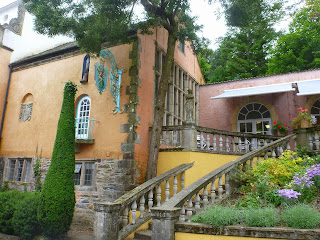In 1925 the “Architect” Clough Williams-Ellis bought a
coastal site to the south of Portmadog in North Wales and spent the next 50
years creating an Italian coastal village there complete with bell towers, churches,
cottages and a town hall to accompany the existing structures on these wooded
slopes which were Castell Denrduth, first mentioned in 1188, and a large mansion
house, now the Portmeirion hotel.
It is
widely believed that Williams-Ellis based his design on the village of
Portofino in Italy, a claim Williams-Ellis strenuously denied.
 |
| Portmeirion |
 |
| Portofino |
Portmeirion is now famous for two things. Firstly as a
setting for the 1967 TV series “The Prisoner” and although I admit haven’t seen
it by all accounts it is a bit surreal and weird so Portmeirion is probably an
appropriate enough setting. Secondly, Portmeirion is famous for its pottery and
although no pottery is, or has ever been, manufactured on the site, the
“Botanics” range launched in 1972 is amongst the most easily recognised design
of pottery in the country. Susan Williams-Ellis, his daughter, founded
Portmeirion pottery in 1960 in Stoke on Trent and in 2009 Portmeirion pottery
purchased the famous names of Spode and Royal Worcester, both founded in the
1770s and the manufacture of these was returned to the UK. Although no
manufacturing takes place at Portmeirion there are no shortage of purchasing
opportunities.
 |
| "Botanics" range |
Clough Williams- Ellis is always described as an “Architect”
but in fact he only stayed at architecture school for a few months (too
non-conformist for that apparently) before setting up his own practice and it
took him 4 years to find and purchase the appropriate site for his master plan.
He wanted to prove that it was possible to build beautiful colourful housing
without defiling the natural landscape. The obvious influences of “rusticity”
and “picturesque” shine through with the inevitable result being a certain
crudeness that comes from mimicry rather than the result of the natural complex
evolution of a village over the centuries reflecting social, economic, technological,
environmental changes and adaptations and these are slow and subtle.
We decided to have lunch in the rather grand building called "The town hall". I was a little disillusioned when this turned out to consist of a school canteen style stainless steel serving counter, the ubiquitous brown plastic trays and the instruction of "cutlery and ketchup are over there". No doubt an essential way of dishing out hundreds of lunches to the peak tourist season crowds but it did somewhat take the shine of the grandeur of the place.
The end result is a theme park, a fun place, a charming and
entertaining tourist holiday attraction and certainly worth a visit…. There’s
even a mock Sistine Chapel ceiling painting….and a fake shipwrecked boat….and a
fake light house…. It’s the sort of architectural equivalent of eating ice
cream – sweet, tasty, fun at the time but ultimately not totally satisfying.
It’s all fake!!!
 |
| Michelangelo would have been proud. |
 |
| A fake lighthouse |
 |
| Boat at the shore.... |
 |
| Going nowhere!! |




















No comments:
Post a Comment